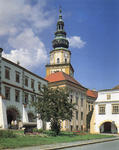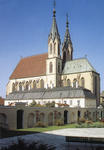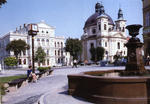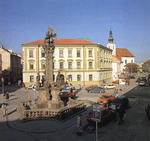
Kromeriz held an important role even during the Great Moravian Empire, as it was a junction of major European roads. The importance of this city declined in the 9
th and 10
th centuries, when the new castle of Bretislav was built in Prerov, and even further when prince Ota II. of Olomouc sold Cerny Kromeriz to the Moravian bishop John.
Roman Kromeriz is mentioned in the immunity certificate of Prince Premysl from 1238. In 1256 Kromeriz is still referred to as a
"market village", but soon afterward it became a Gothic city. Bishop Bruno of Schauenburg established the Gothic city of Kromeriz and the Church of St. Morris. He rebuilt the Parish Church of the Virgin Mary in the market village, and in place of the Roman court he established an Early Gothic fortress which was typically used as the seat of the bishops of Olomouc, since the founding of Brno. The medieval Kromeriz was a combination of three elements - the seat of the owner and two market villages (one Slavic, one colonial). Since 1322, a Jewish town also developed, though it was isolated from the beginning of the 18
th century.
King Wenceslas IV. conferred upon the city all privileges in 1411. During the Hussite wars, the city was sold or used as collateral several times, but after the battle of Bila Hora, it was returned to the bishop. After the destruction of the city in 1643, Charles of Lichtenstein initiated an extensive renovation of Kromeriz. During the construction of the Bishop of Kromeriz's castle and gardens, the work of many sculptors was employed to realize sculptures based on mythical and allegorical themes.
Under the rule of Cardinal Schrattenbach, from 1724-1736,
the Baroque Church of the Virgin Mary was built. The greatest construction event of Baroque Kromeriz was the establishment of the Church of St. John the Baptist.
Under the ruling of Olomouc's Archbishop Ant. Th. Colloredo-Waldsee, the city of Kromeriz was again raised in status. In the 18
th century the Franciscan monastery was closed. The Enlightenment and Renaissance are reflected in the look of the castle's parks, which were further altered during following centuries. Kromeriz eliminated medieval establishments such as city gates and walls,

and bourgeois houses underwent modifications.
Visitors to Kromeriz can see the rich artistic legacy of the city, which has been protected and restored for decades as a cultural heritage of the city.
The early medieval market village of Kromeriz which had since the start of the 12
th century been the property of the Olomouc-based bishops was elevated to the rank of town around the year 1260. The bishops set up their summer residence and the administration of the property belonging to the Olomouc diocese there. Added to the stately residence later were three churches, a chapter, and several schools.
On a site where a farmstead had stood before a Gothic castle was built which later evolved into a
Renaissance stronghold. In the second half of the l7
th century, after the Thirty Years' War, the educated and wealthy bishop Karl Liechtenstein of Castelcorn managed to raise the town from ruins and built an Early Baroque residence there where he placed a
collection of works by leading European painters and established a
large library full of rare books. A mint was built outside the chateau where special coins and medals were minted.
The chateau, rebuilt in its current appearance after a fire in 1752, was in late 1848 and early 1849 the venue of a parliament session which approved the first democratic Constitution in central Europe. Though not implemented at its time it was an inspiring example for the future. The chateau, its historical interiors, the picture gallery, library, sala terrena, Snemovni (Assembly) and Mansky (Vassal) halls, together with two gardens comprise a unique whole whose inclusion on the UNESCO World Heritage List only confirms the significance of Kromeriz's major landmarks as part of the world's cultural heritage.



 Guide
Guide 





